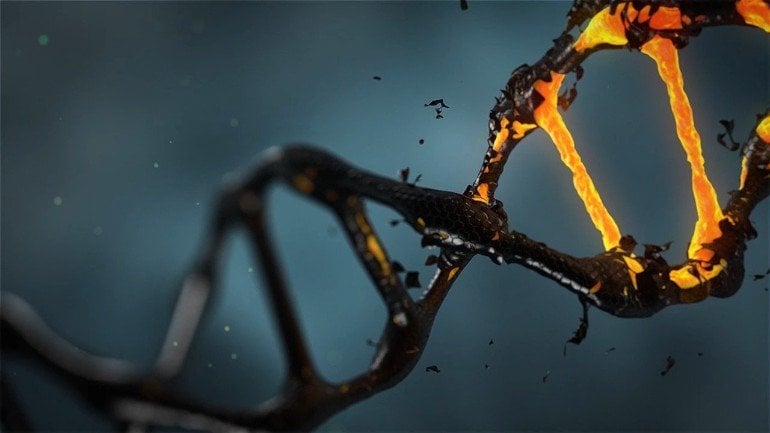Summary: A novel method detected conformational changes to the TDP-43 protein in cerebral spinal fluid associated with ALS.
Source: RUB
ALS is a fatal neurodegenerative disease causing a rapid loss of motor function, which usually results in a serious condition with early death within a few years. So far, early and precise diagnosis of the disease has been difficult. Stephen Hawking was one of the most prominent patients. In summer 2014, the disease gained media attention through a large-scale fundraising campaign, the so-called Ice Bucket Challenge.
To date, one of the most important challenges in ALS diagnostics is to exclude other mimicking diseases and to reliably verify an exact diagnosis. In ALS, the TDP-43 protein in particular plays a pivotal role. It forms small inclusions in nerve cells. TDP-43 inclusions appear to have a crucial pathomechanistic significance and are the neuropathological markers in sporadic and many genetic ALS cases. They have been detected in numerous brain autopsies of ALS patients. In this study, the Bochum researchers and their colleagues showed that pathologically misfolded forms of the protein also occur in solution in the nerve fluid and can be specifically analysed there.
Dr. Rene Günther, one of the lead authors of the study and head of the research group and specialist outpatient clinic for motor neuron diseases at the Department of Neurology of the Carl Gustav Carus University Hospital at the Technical University of Dresden, explains: “Biomarker research plays a crucial role in improving early detection and securing the diagnosis of amyotrophic lateral sclerosis.
In addition, biomarkers are a basis for successful drug testing and therapy development in this dramatically progressing and difficult to treat disease. So far, only disease-unspecific biomarkers are available. In our pilot study, we successfully identified conformational changes of TDP-43 proteins in the cerebrospinal fluid of patients with amyotrophic lateral sclerosis for the first time using this innovative method.” Pilot study shows potential
The team led by Lars Tönges and Klaus Gerwert succeeded in securing a diagnosis of the disease based on the altered structure of the protein TDP-43. In the process, the researchers showed that the proteins fold from predominantly disordered and helical structures to so-called ß-sheets. These shapes promote damage assemblies and deposits of the protein in nerve cells. In the analysis, 36 ALS patients were distinguished from 30 Parkinson’s patients by means of the TDP-43 signal with a sensitivity of 89 per cent and a specificity of 77 per cent.
In addition, a control group with neurologically inconspicuous patients was differentiated with a sensitivity of 89 per cent and a specificity of 83 per cent. By analysing TDP-43, the researchers were thus able to exclude other diseases that affect motor function, such as Parkinson’s disease. These results will be verified and validated in a larger study.
Optimisation of the Alzheimer’s sensor
Klaus Gerwert’s immuno-infrared sensor has already been used in earlier studies to detect pathologically altered proteins in the blood of patients with Alzheimer’s disease before symptoms occur. In this case, the technology has been optimised and refined for use in the cerebrospinal fluid of patients with ALS.
This shows that the potential of the method for other neurological diseases should also be explored. In close collaboration with Professor Ralf Gold, Director of the Department of Neurology at St. Josef-Hospital Bochum and Head of Research at the Prodi Department of Experimental Medicine, further projects are currently being undertaken to gain a better understanding of neurological disease processes.

Léon Beyer, one of the lead authors of the study and PhD student at the Prodi Biospectroscopy Department, says: “This achievement may provide new insight into the mechanisms of the disease. Compared to other methods that reflect concentrations of certain proteins, our infrared sensor technology gives insights into molecular events and may therefore become a crucial tool in the future for diagnosing and for developing clinical therapies. First and foremost, however, it will contribute greatly to a more precise understanding of diseases.”
Future will reveal value for clinical applications
In the future, the results of validation studies should provide information on whether the pathologically modified TDP-43 proteins can be used in clinical applications to facilitate earlier and more precise diagnoses and to gain new molecular insights.
Funding: The study was carried out at the Centre for Protein Diagnostics (funding code: 111.08.03.05-133974) and the Pure Consortium (funding code: 233-1.08.03.03.-031-68079), funded by the Ministry of Culture and Science of North Rhine-Westphalia. In addition, the clinical studies were commissioned the niemALS association and funded by Hermann-und-Lilly-Schilling-Stiftung für medizinische Forschung in Stifterverband.
About this ALS research news
Source: RUB
Contact: Rene Günther – RUB
Image: The image is in the public domain
Original Research: Closed access.
“TDP‐43 as structure‐based biomarker in amyotrophic lateral sclerosis” by Rene Günther et al. Annals of Clinical and Translational Neurology
Abstract
TDP‐43 as structure‐based biomarker in amyotrophic lateral sclerosis
Pathologic alterations of Transactivation response DNA‐binding protein 43 kilo Dalton (TDP‐43) are a major hallmark of amyotrophic lateral sclerosis (ALS). In this pilot study, we analyzed the secondary structure distribution of TDP‐43 in cerebrospinal fluid of ALS patients (n = 36) compared to Parkinson´s disease patients (PD; n = 30) and further controls (Ctrl; n = 24) using the immuno‐infrared sensor technology. ALS patients could be discriminated from PD and Ctrl with a sensitivity/specificity of 89 %/77 % and 89 %/83 %, respectively. Our findings demonstrate that TDP‐43 misfolding measured by the immuno‐infrared sensor technology has the potential to serve as a biomarker candidate for ALS.






